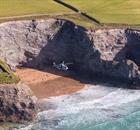FLYING TIGERS PRACTICE WINCHING SKILLS
A Merlin helicopter, from 814 Naval Air Squadron (The Flying Tigers) practiced its winching techniques on the rocky cliffs of West Cornwall, near its Fleet Air Arm base at Royal Naval Air Station Culdrose.
Utilising its onboard winch the crew of the Merlin Mk 2, were conducting rescue training that is often called upon whilst on operations, whether deployed to any location across the World or with the Fleet as part of a dedicated Air Group.
“80% of the world’s population live within 60 miles of the coast. The sea plays a major role in all of our lives, the food we eat, the cars we drive and the holidays we take practically all rely on sea trade or sea travel,” said Commander Brendan Spoors, CO of 814 NAS. “The Royal Navy has a duty to protect those at sea and repeatedly our helicopter crews are inevitably called on to assist, in much worst conditions than we practiced today. Our men and women train to the highest standards and practice these skills as often as we can. A call can come out of nowhere. Meaning that our expert Pilots, Observers and Aircrewmen can be hunting a submarine one minute, next be hovering feet away from sheer cliffs in thick fog and being winched out of the door often at great risk to themselves”
‘The Flying Tigers’ still have squadron memories of being called out for rescue missions in their recent history. 16 years earlier, during a large NATO exercise in the Mediterranean on 26 September 2000, a Sea King embarked on HMS Invincible launched to assist rescue efforts in the Aegean Sea, where a Greek Ferry had struck rocks. The MS Express Samnia was carrying 533 passengers between Piraeus and Paros. The 814 helicopter was one of the first on scene as reports came through of crew and passengers beginning to abandon ship. Many swum to rocks along the coast and using their radar the crew got close enough to sight survivors who were hanging on for dear life. It was then down to the Observer and Aircrewman to be winched on to the rocky cliffs and rescue the survivors.
“This was my first experience of cliff winching,” said Leading Aircrewman Arron Tobin. “Being lowered down to a cliff top then slowly lowered down to an exact spot on a cliff. Of course, I enjoy it as it is a great adrenaline rush but that is not to say that it’s easy. Being dangled 100ft below the helicopter over rocks has put being dangled over the sea in perspective.”





